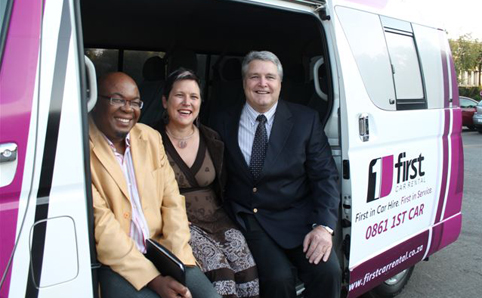Latest News Archive
Please select Category, Year, and then Month to display items
05 June 2018
Photo Supplied
 Archaeological excavations in the Wonderwerk Cave, north of Kuruman in the Northern Cape.
Archaeological excavations in the Wonderwerk Cave, north of Kuruman in the Northern Cape.
Research fellow Dr Lloyd Rossouw from the Department of Plant Sciences at the University of the Free State (UFS) recently published an article in the Nature Ecology and Evolution journal with Dr Michaela Ecker from the University of Toronto as lead author, and Dr James Brink, research fellow at the UFS Centre for Environmental Management. The findings described in “The palaeoecological context of the Oldowan-Acheulean in southern Africa” provides the first extensive paleoenvironmental sequence for the interior of southern Africa by applying a combination of methods for environmental reconstruction at Wonderwerk Cave, which have yielded multiple evidence of early human occupation dating back almost two million years ago.
Where water once was
The Wonderwerk Cave is found north of the Kuruman hills (situated in Northern Cape) a 140m long tube with a low ceiling. The surroundings are harsh. Semi-arid conditions allow for the survival of only hardy bushes, trees, and grasses. But during the Early Pleistocene, stepping out of the Wonderwerk Cave you would have been greeted by a completely different site, the researchers found. Using carbon and oxygen stable isotope analysis on the teeth of herbivores (Dr Ecker), fossil faunal abundance (Dr Brink), as well as the analysis of microscopic plant silica remains (phytoliths) excavated from fossil soils inside the cave (Dr Rossouw), the results show that ancient environments in the central interior of southern Africa were significantly wetter and housed a plant community unlike any other in the modern African savanna.
What difference does it make?
While East African research shows increasing aridity and the spread of summer-rainfall grasslands more than a million years ago, the results from this study indicate an interesting twist. During the same period, shifts in rainfall seasonality allowed for alternating summer and winter-rainfall grass occurrences coupled with prolonged wetlands, that remained major components of Early Pleistocene (more or less the period between one and two million years ago) environments in the central interior of southern Africa. That means our human ancestors were also living and evolving in environments other than the generally accepted open, arid grassland model.
New wheels for students with disabilities
2012-06-06
 |
|
First Car Rental donated two vehicles to our Unit for Students with Disabilities to meet their transport needs. The minibus will later on be converted to meet the specific transport needs of students with disabilities. From the left are Mr Mokgethi Tshabalala, Executive Head of Thebe Foundation, Mrs Hetsie Veitch, Head of the USD and Mr Bruce Barritt, Managing Director of First Car Rental.
Photo: René-Jean der Berg
06 June 2012
|
Transport problems of students at our Unit for Students with Disabilities (USD) are now something of the past.
The USD received two brand-new vehicles from First Car Rental, a vehicle rental company, for the transportation of students with disabilities.
“The vehicles are especially useful to transport students of the unit to and from classes and examinations between the two campuses in Bloemfontein. It also helps us to transport students should they have doctors’ appointments or to perhaps have their physical aids serviced,” says Mrs Martie Marina, senior officer at the Unit for Students with Disabilities.
The two vehicles consist of a passenger vehicle and a minibus. The minibus will later on be converted to meet the specific needs of the students.